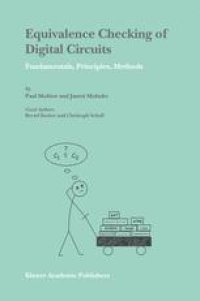
Ebook: Equivalence Checking of Digital Circuits: Fundamentals, Principles, Methods
- Tags: Circuits and Systems, Electronic and Computer Engineering, Computing Methodologies, Computer-Aided Engineering (CAD CAE) and Design
- Year: 2004
- Publisher: Springer US
- Edition: 1
- Language: English
- pdf
Hardware veri?cation is the process of checking whether a design conforms to its speci?cations of functionality and timing. In today’s design processes it becomes more and more important. Very large scale integrated (VLSI) circuits and the resulting digital systems have conquered a place in almost all areas of our life, even in security sensitive applications. Complex digital systems control airplanes, have been used in banks and on intensive-care units. Hence, the demand for error-free designs is more important than ever. In addition, economic reasons underline this demand as well. The design and production process of present day VLSI-circuits is highly time- and cost-intensive. Mo- over, it is nearly impossible to repair integrated circuits. Thus, it is desirable to detect design errors early in the design process and not just after producing the prototype chip. All these facts are re?ected by developing and prod- tion statistics of present day companies. For example, In?neon Technologies [118] assumed that about 60% to 80% of the overall design time was spent for veri?cation in 2000. Other sources cite the 3-to-1 head count ratio between veri?cation engineers and logic designers. This shows that verifying logical correctness of the design of hardware systems is a major gate to the problem of time-to-market (cf. [113]). With the chip complexity constantly increasing, the dif?culty as well as the - portance of functional veri?cation of new product designs has been increased. It is not only more important to get error-free designs.
With the chip complexity constantly increasing, the difficulty as well as the importance of functional verification of new product designs has been increased. It is not only more important to get error-free designs. Moreover, it becomes an increasingly difficult task for a team of human designers to carry out a full design without errors. The traditional training of new verification engineers has to be adapted to the new situation. New skills are necessary. For these reasons, nearly all major universities offer lectures on basic verification techniques such as propositional temporal logic, model checking, equivalence checking, and simulation coverage measures. The present book is designed as a textbook covering one of the most important aspects in the verification process &endash; equivalence checking of Boolean circuits.
Equivalence Checking of Digital Circuits is a textbook for advanced students in electrical and computer engineering, but is also intended for researchers who will find it useful as a reference text.
With the chip complexity constantly increasing, the difficulty as well as the importance of functional verification of new product designs has been increased. It is not only more important to get error-free designs. Moreover, it becomes an increasingly difficult task for a team of human designers to carry out a full design without errors. The traditional training of new verification engineers has to be adapted to the new situation. New skills are necessary. For these reasons, nearly all major universities offer lectures on basic verification techniques such as propositional temporal logic, model checking, equivalence checking, and simulation coverage measures. The present book is designed as a textbook covering one of the most important aspects in the verification process &endash; equivalence checking of Boolean circuits.
Equivalence Checking of Digital Circuits is a textbook for advanced students in electrical and computer engineering, but is also intended for researchers who will find it useful as a reference text.
Content:
Front Matter....Pages i-xiii
Introduction....Pages 1-6
Preliminaries....Pages 9-22
Representation of Boolean and Pseudo Boolean Functions....Pages 23-65
Use of Canonical Data Structures....Pages 71-97
SAT and ATPG Based Equivalence Checking....Pages 99-130
Exploiting Similarities....Pages 131-143
Checking Equivalence for Partial Implementations....Pages 145-167
Permutation Independent Boolean Comparison....Pages 169-204
Formal Basics....Pages 209-226
The Latch Correspondence Problem....Pages 227-239
Back Matter....Pages 243-263
With the chip complexity constantly increasing, the difficulty as well as the importance of functional verification of new product designs has been increased. It is not only more important to get error-free designs. Moreover, it becomes an increasingly difficult task for a team of human designers to carry out a full design without errors. The traditional training of new verification engineers has to be adapted to the new situation. New skills are necessary. For these reasons, nearly all major universities offer lectures on basic verification techniques such as propositional temporal logic, model checking, equivalence checking, and simulation coverage measures. The present book is designed as a textbook covering one of the most important aspects in the verification process &endash; equivalence checking of Boolean circuits.
Equivalence Checking of Digital Circuits is a textbook for advanced students in electrical and computer engineering, but is also intended for researchers who will find it useful as a reference text.
Content:
Front Matter....Pages i-xiii
Introduction....Pages 1-6
Preliminaries....Pages 9-22
Representation of Boolean and Pseudo Boolean Functions....Pages 23-65
Use of Canonical Data Structures....Pages 71-97
SAT and ATPG Based Equivalence Checking....Pages 99-130
Exploiting Similarities....Pages 131-143
Checking Equivalence for Partial Implementations....Pages 145-167
Permutation Independent Boolean Comparison....Pages 169-204
Formal Basics....Pages 209-226
The Latch Correspondence Problem....Pages 227-239
Back Matter....Pages 243-263
....